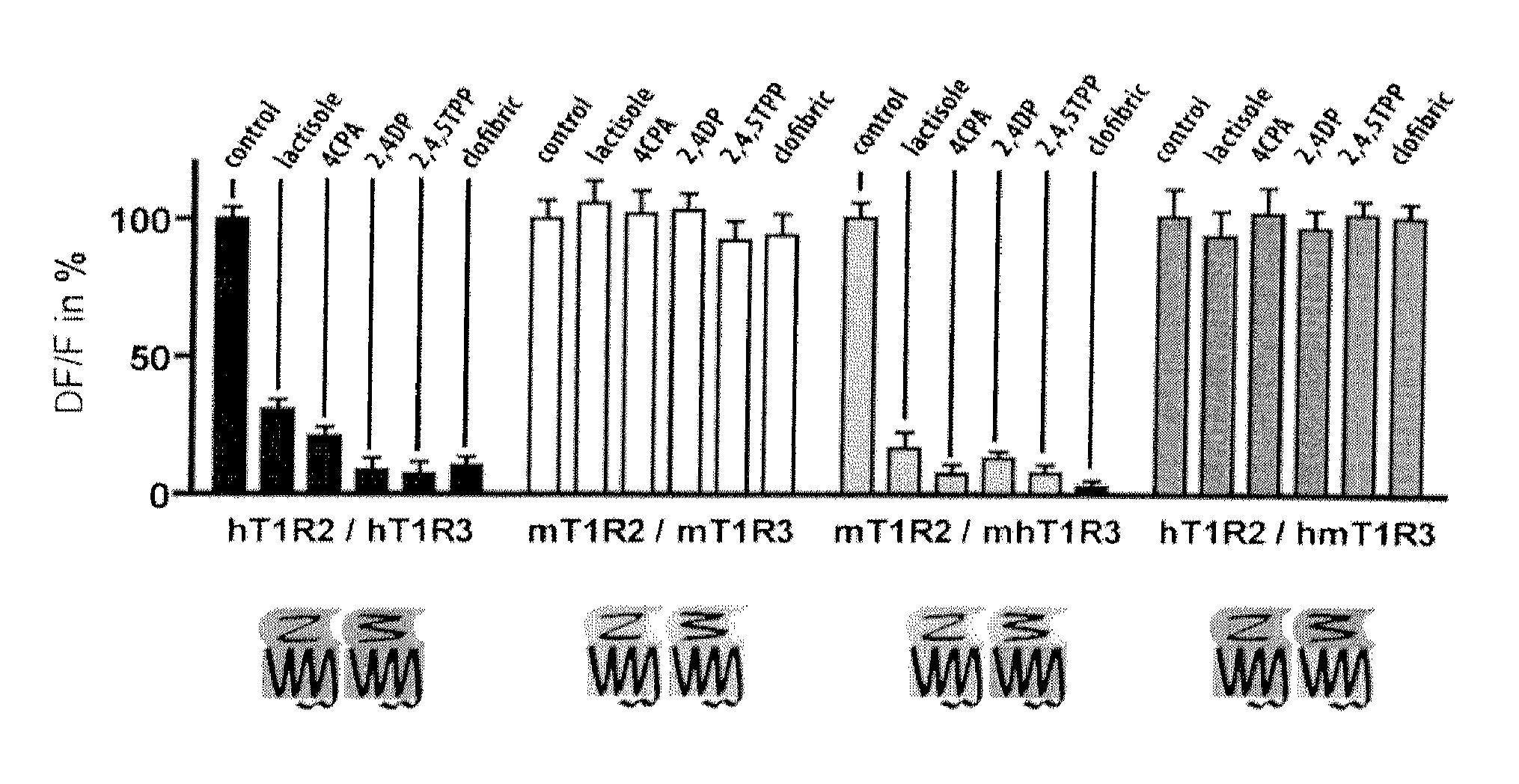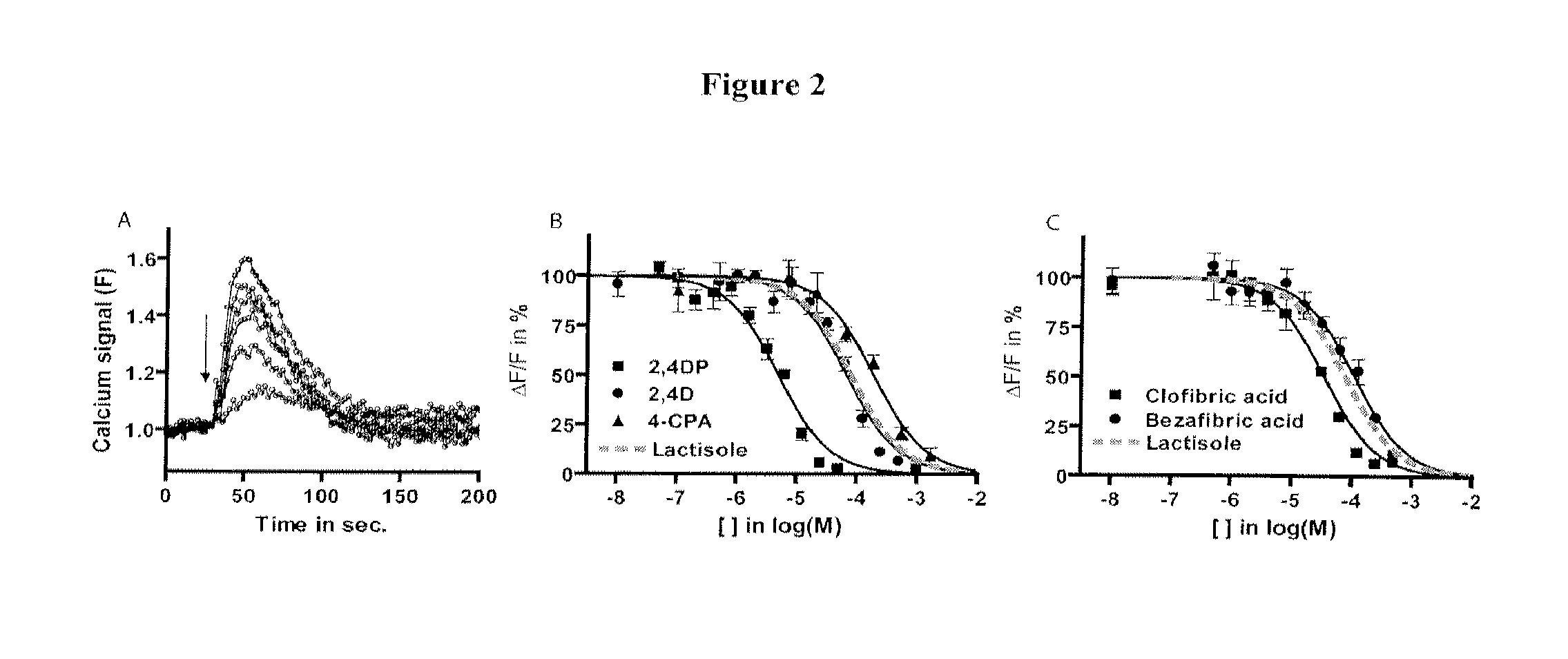Human type i taste receptor subunit 3 modulators and methods of using same
a technology subunit 3 is applied in the field of materials and methods for modulating the activity of human type i taste receptor subunit 3 and the like, which can solve the problem that little attention has been paid to the physiological effects of artificial sweeteners beyond their sweet tas
- Summary
- Abstract
- Description
- Claims
- Application Information
AI Technical Summary
Benefits of technology
Problems solved by technology
Method used
Image
Examples
example 1
Phenoxy Herbicides and Fibrates Potently Inhibit the Human T1R3 Chemosensor Receptor
[0138]Materials and Methods
[0139]Chemicals:
[0140]Chemicals were obtained from Sigma-Aldrich. Purity of all chemicals used was at least >98%. Fibrates and herbicides were used as acids, their active forms, as shown in FIG. 1. 10 mM solutions were prepared in DMSO or water according to the compounds' solubility. Chemical structures were generated using the ChemSketch2.0 software.
[0141]DNA Constructs:
[0142]Human and mouse T1R2 and T1R3 chimeras, and the G 16-gust44 were prepared in pcDNA3 vector as described in (Xu, H., et al., Proc Natl Acad Sci USA, 2004, 101, 14258-14263; and Jiang, P. et al., J Biol Chem 2005, 280, 15238-15246; each hereby incorporated by reference in their entirety). The integrity of all DNA constructs was confirmed by sequencing.
[0143]Heterologous Calcium Assay for Sweet-Sensing Receptors:
[0144]HEK293E cells were cultured at 37° C. in Optimem GlutaMAX culture medium (Invitrogen) s...
example 2
Animal Model for Screening Inhibitory Compounds Binding to Transmembrane Domain
[0161]Preparation of Constructs
[0162]Two chimeric T1R3 receptors were constructed. One (designated ½) contains the entire extracellular domain of the mouse T1R3, while the intracellular end-portion (described also as transmembrane domain) of the mouse receptor (starting at amino acid 567) was replaced by human sequence (starting at amino acid 568). The second construct (designated 1 / 10) has only trans-membrane domain 5 and 6 of the mouse T1R3 replaced by the human sequence which is the part required for lactisole, fibrates and phenoxyauxin-herbicide's binding. Both receptors express well in cell-based assays and pair with mouse T1R2 receptor, forming a fully-functional sweet receptor that is inhibited by lactisole. Studies with analogous T1R3 chimeric receptors have been published (Xu 2004, Jiang 2005). The entire human T1R3 receptor cannot be used because it does not form, for unknown reasons, a function...
example 3
Tissue Expression Using Transgenic Mice
[0171]The constructs described in Example 2 were used to prepare transgenic mice expressing the chimeric receptor (the ½ construct). GFP expression revealed that the transgene (GFP) is expressed in taste cells, and also in pancreatic islets, gut mucosal cells (enteroendocrine), and importantly, very strongly in tubular cells in testis. Expression was also observed in several areas of the brain and in retina.
[0172]Expression of T1R3-GFP in testis of transgenic mice is shown in FIG. 8 using frozen tissue sections of testis from T1R3-mhT1R3-IRES-GFP mouse. GFP fluorescence is strong in spermatocytes and spermatids inside the testicular tubules (arrows). The signal on the periphery of tubules is a nonspecific autofluorescence visible in any WT mouse tissue. Expression of T1R3-GFP in gut of transgenic mice is shown in FIG. 9 using frozen tissue sections of duodenum, jejunum, proximal and distal colon (clockwise) from T1R3-mhT1R3-IRES-GFP mouse. Soli...
PUM
| Property | Measurement | Unit |
|---|---|---|
| Molar density | aaaaa | aaaaa |
| Molar density | aaaaa | aaaaa |
| Molar density | aaaaa | aaaaa |
Abstract
Description
Claims
Application Information
 Login to View More
Login to View More - R&D
- Intellectual Property
- Life Sciences
- Materials
- Tech Scout
- Unparalleled Data Quality
- Higher Quality Content
- 60% Fewer Hallucinations
Browse by: Latest US Patents, China's latest patents, Technical Efficacy Thesaurus, Application Domain, Technology Topic, Popular Technical Reports.
© 2025 PatSnap. All rights reserved.Legal|Privacy policy|Modern Slavery Act Transparency Statement|Sitemap|About US| Contact US: help@patsnap.com



